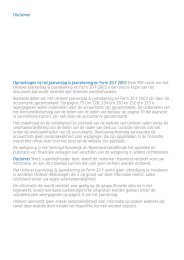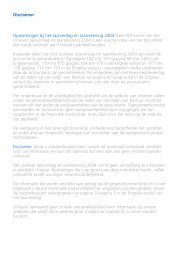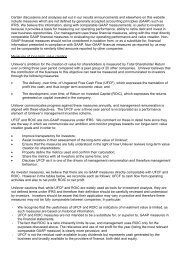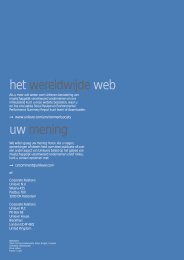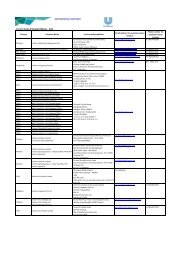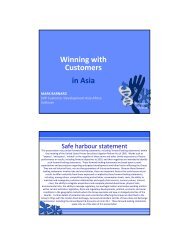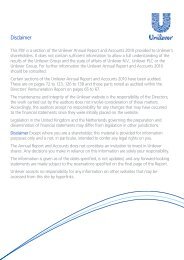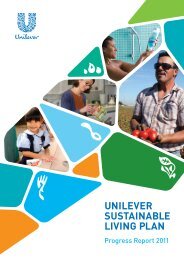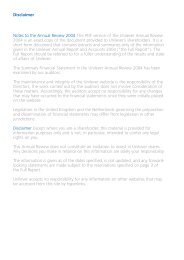Unilever Annual Report & Accounts and Form 20-F 2000
Unilever Annual Report & Accounts and Form 20-F 2000
Unilever Annual Report & Accounts and Form 20-F 2000
- TAGS
- unilever
- annual
- accounts-and-form
- f
Create successful ePaper yourself
Turn your PDF publications into a flip-book with our unique Google optimized e-Paper software.
28<br />
<strong>Unilever</strong> <strong>Annual</strong> <strong>Report</strong> & <strong>Accounts</strong> <strong>and</strong> <strong>Form</strong> <strong>20</strong>-F <strong>20</strong>00<br />
Financial review<br />
Treasury <strong>and</strong> hedging policies<br />
<strong>Unilever</strong>’s Treasury objective is to maintain <strong>Unilever</strong>’s financial<br />
strength <strong>and</strong> flexibility within the context of the long-term<br />
financial strategy set out in the ‘Finance <strong>and</strong> liquidity’<br />
section above.<br />
<strong>Unilever</strong>'s Treasury operates as a cost centre <strong>and</strong> is governed<br />
by policies <strong>and</strong> plans agreed by the directors. In addition<br />
to policies, guidelines <strong>and</strong> exposure limits, a system of<br />
authorities <strong>and</strong> extensive independent reporting covers all<br />
major areas of activity. Performance is monitored closely.<br />
Independent reviews are undertaken by the corporate<br />
internal audit function.<br />
<strong>Unilever</strong> has an interest rate management policy aimed<br />
at optimising net interest cost <strong>and</strong> reducing volatility.<br />
This is achieved by modifying the underlying interest rate<br />
exposure of debt <strong>and</strong> cash positions through the use of<br />
straightforward derivative instruments. The proportion of<br />
fixing was increased significantly following the increase in<br />
debt resulting from the various acquisitions in <strong>20</strong>00.<br />
Under the Group’s foreign exchange policy, trading <strong>and</strong><br />
financial transaction exposures are generally hedged, mainly<br />
through the use of forward foreign exchange contracts.<br />
Some flexibility is permitted within overall exposure limits.<br />
Assets held in foreign currencies are, to a considerable<br />
extent, financed by borrowings in the same currencies.<br />
Managing market risks<br />
The Group is exposed to a variety of market risks, including<br />
the effects of changes in foreign currency exchange rates,<br />
interest rates <strong>and</strong> credit spreads. In the normal course<br />
of business, the Group also faces risks that are either<br />
non-financial or non-quantifiable, for example country<br />
<strong>and</strong> counterparty risks.<br />
Counterparty exposures are minimised by restricting dealing<br />
counterparties to a limited number of financial institutions<br />
that have secure credit ratings, by working within agreed<br />
counterparty limits <strong>and</strong> by setting limits on the maturity<br />
of investments. Counterparty credit ratings are closely<br />
monitored <strong>and</strong> concentration of credit risk with any<br />
single counterparty is avoided.<br />
The Group uses straightforward derivative financial<br />
instruments, for example interest rate swaps, forward rate<br />
agreements <strong>and</strong> forward exchange contracts, to manage the<br />
market risks associated with the underlying assets, liabilities<br />
<strong>and</strong> anticipated transactions. The Group uses these<br />
derivative financial instruments to reduce risk by creating<br />
offsetting market exposures. The use of leveraged<br />
instruments is not permitted.<br />
The following discussion about our risk management<br />
activities includes ‘forward-looking’ statements that involve<br />
risk <strong>and</strong> uncertainties. Our actual results could differ<br />
materially from those projected. See the ‘Cautionary<br />
Statement’ at the front of this document.<br />
<strong>Report</strong> of the Directors<br />
The analysis below presents the sensitivity of the fair value<br />
of the financial <strong>and</strong> derivative instruments the Group held<br />
at 31 December <strong>20</strong>00, to the hypothetical changes<br />
described below.<br />
Interest rate risk<br />
The fair value of debt, investments <strong>and</strong> related hedging<br />
instruments is affected by movements in interest rates.<br />
The analysis shows the sensitivity of the fair value of<br />
interest rate sensitive instruments to a hypothetical 10%<br />
change in the interest rates across all maturities as at<br />
31 December <strong>20</strong>00.<br />
Foreign exchange rate risk<br />
The fair value of debt, investments <strong>and</strong> hedging<br />
instruments, denominated in currencies other than the<br />
functional currency of the entities holding them, are<br />
subject to exchange rate movements. The analysis shows<br />
the sensitivity of these fair values to a hypothetical 10%<br />
change in foreign exchange rates as at 31 December <strong>20</strong>00.<br />
Fair value changes Sensitivity to a hypothetical<br />
10% adverse movement in<br />
rates as at 31 December<br />
(€ million)<br />
<strong>20</strong>00 1999<br />
Interest rate risk 338 4<br />
Foreign exchange rate risk 1 16<br />
Further details on derivatives, foreign exchange exposures<br />
<strong>and</strong> other related information on financial instruments are<br />
given in note 30 on page 74.<br />
Supply risk <strong>and</strong> commodities contracts<br />
<strong>Unilever</strong>’s products are manufactured from a number<br />
of raw materials. While materials are expected to be in<br />
adequate supply, any shortages or disruptions in supply<br />
would have a material adverse effect on gross margin.<br />
Some of our businesses, principally edible fats companies<br />
in Europe, may use forward contracts in a number of oils<br />
to hedge future requirements. We purchase forward<br />
contracts in bean, rape, sunflower, palm, coconut <strong>and</strong><br />
palm kernel oils, almost always for physical delivery.<br />
We may also use futures contracts to hedge future price<br />
movements; however, the amounts are not material.<br />
The total value of open futures contracts at the end<br />
of <strong>20</strong>00 was not material.<br />
In addition, our plantations businesses may use forward<br />
contracts for physical delivery of palm oil <strong>and</strong> tea under<br />
strictly controlled policies <strong>and</strong> exposure limits. We did<br />
not have any outst<strong>and</strong>ing futures contracts at the end<br />
of <strong>20</strong>00.<br />
Distribution<br />
<strong>Unilever</strong>’s products are generally sold through its sales force<br />
<strong>and</strong> through independent brokers, agents <strong>and</strong> distributors to<br />
chain, wholesale, co-operative <strong>and</strong> independent grocery



